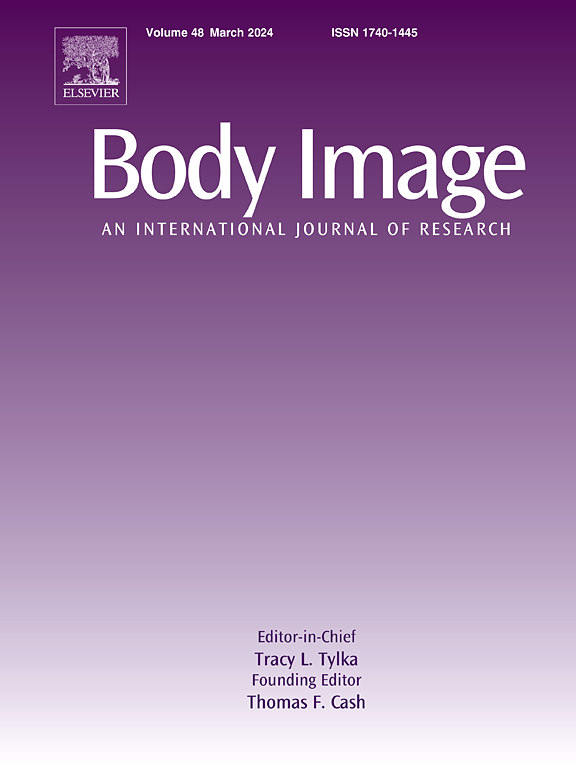Links of weight and muscularity teasing with eating disorder symptomatology, eating-related psychosocial impairment, and intuitive eating in Chinese men: Teasing directions and combinations matter
IF 5.2
1区 心理学
Q1 PSYCHIATRY
引用次数: 0
Abstract
Empirical evidence, based on variable-centered approaches (e.g., correlation and regression analyses), supports robust links between weight and muscularity teasing and eating variables in men. However, limited research has considered the directions (i.e., high and low) of teasing or their combinations via person-centered approaches (e.g., latent class analysis). Thus, this study explored the relationships between four types of teasing (i.e., teasing for high weight, low weight, high muscularity, and low muscularity) and eating variables in 596 Chinese adult men using variable and person-centered approaches. Independent t-tests and regression analyses revealed that four types of teasing had unique associations with eating disorder (ED) symptomatology, eating-related psychosocial impairment, and intuitive eating. Latent class analysis identified four distinct teasing classes, including High Weight-Low Muscularity, Low Weight-Low Muscularity, Low Teasing, and High Weight-High Muscularity. Notably, individuals in the Low Teasing group consistently showed the lowest ED symptomatology and psychosocial impairment and the highest intuitive eating. Individuals in the High Weight-High Muscularity group exhibited the highest traditional ED symptomatology and the most severe psychosocial impairment. The findings highlight the importance of future research considering teasing directions and tailored interventions for adult men in certain subgroups at risk of eating disorder psychopathology (e.g., the High Weight-High Muscularity teasing group).
中国男性的体重和肌肉挑逗与饮食失调症状、饮食相关的社会心理障碍和直觉饮食之间的联系:挑逗的方向和组合很重要。
基于以变量为中心的方法(如相关和回归分析)的经验证据支持男性体重和肌肉戏弄与饮食变量之间的紧密联系。然而,通过以人为中心的方法(如潜类分析)来考虑戏弄的方向(即高和低)或它们的组合的研究却很有限。因此,本研究采用变量和以人为中心的方法,探讨了 596 名中国成年男性中四种类型的取笑(即对高体重、低体重、高肌肉和低肌肉的取笑)与饮食变量之间的关系。独立 t 检验和回归分析表明,四种类型的挑逗与进食障碍(ED)症状、与进食相关的社会心理障碍和直觉进食有独特的关联。潜类分析确定了四种不同的挑逗类型,包括高体重-低肌肉含量、低体重-低肌肉含量、低挑逗和高体重-高肌肉含量。值得注意的是,低挑逗组中的个体始终表现出最低的 ED 症状和心理社会损伤,以及最高的直觉饮食。高体重-高肌肉发达组的个体表现出最高的传统 ED 症状和最严重的心理社会损伤。研究结果强调了未来研究考虑挑逗方向的重要性,以及针对某些有饮食失调心理病理学风险的亚组(如高体重-高肌肉度挑逗组)成年男性进行有针对性干预的重要性。
本文章由计算机程序翻译,如有差异,请以英文原文为准。
求助全文
约1分钟内获得全文
求助全文
来源期刊

Body Image
Multiple-
CiteScore
8.70
自引率
28.80%
发文量
174
期刊介绍:
Body Image is an international, peer-reviewed journal that publishes high-quality, scientific articles on body image and human physical appearance. Body Image is a multi-faceted concept that refers to persons perceptions and attitudes about their own body, particularly but not exclusively its appearance. The journal invites contributions from a broad range of disciplines-psychological science, other social and behavioral sciences, and medical and health sciences. The journal publishes original research articles, brief research reports, theoretical and review papers, and science-based practitioner reports of interest. Dissertation abstracts are also published online, and the journal gives an annual award for the best doctoral dissertation in this field.
 求助内容:
求助内容: 应助结果提醒方式:
应助结果提醒方式:


